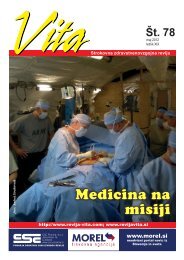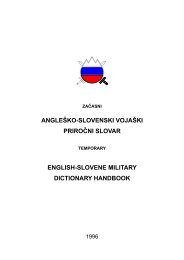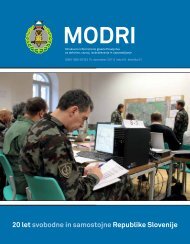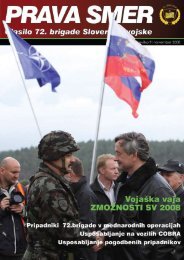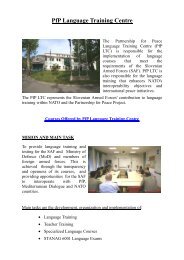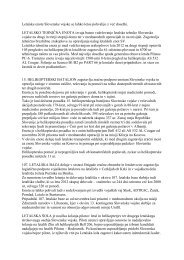Letnik 9/2, september 2007 - Slovenska vojska
Letnik 9/2, september 2007 - Slovenska vojska
Letnik 9/2, september 2007 - Slovenska vojska
You also want an ePaper? Increase the reach of your titles
YUMPU automatically turns print PDFs into web optimized ePapers that Google loves.
John J. Le Beau<br />
going through the right door, at the right time; the silent weapon of actionable<br />
intelligence.<br />
To be sure, intelligence collection and direct action against terrorist targets is a<br />
decidedly high-risk enterprise. This does not refer so much to the physical risk<br />
to intelligence, law enforcement or military officers involved (although this can<br />
of course be considerable) but rather to the significant chances that information<br />
may be inaccurate, fraudulent or dated. With the best of planning and intentions,<br />
the boot can still go through the wrong door or, more tragically, the bullet can<br />
go through the wrong head. (Gall and Jehl, 2006) Much of this has to do with<br />
the nature of the intelligence beast. The “craft of intelligence” is a useful phrase,<br />
suggesting that intelligence collection and analysis is a composite of science and<br />
art. Statistical modeling, link analysis and the empirical examination of evidence<br />
share the stage with a Case Officer’s personal assessment of a human penetration<br />
of a terrorist organization or his reading of a liaison partners’ integrity. There<br />
is substantial room for error which, in the counterterrorist arena, can have fatal<br />
consequences. Accordingly, any joint intelligence arrangement to share information<br />
and act upon it should acknowledge and accept this element of risk at the inception,<br />
to avoid recriminations at a later stage.<br />
At the present juncture in the post-9/11 struggle against Islamist terrorism, a<br />
number of observations can be made with some certainty. First, intelligence<br />
information, obtained via human and technical means, has in the last five years<br />
played a significant role in eliminating individual terrorists through killing or<br />
capture, and in seriously degrading the operational capabilities (to include the<br />
ability to conduct specific attacks, support infrastructure and financial mechanisms)<br />
of al-Qaeda and other organizations. This holds true in war zones such as Iraq<br />
and Afghanistan as well as in areas not experiencing combat. Indeed, the muchremarked-on<br />
transformation of al-Qaeda from a structured organization to a<br />
more diffuse movement (as noted by former DNI John Negroponte) would seem<br />
to be a direct consequence of the effectiveness of applied intelligence. Second,<br />
the amount of intelligence cooperation between U.S. and foreign intelligence<br />
services has increased steadily since the attacks on New York and Washington.<br />
This interservice cooperation against terrorist targets extends from the Middle<br />
East to Asia to Europe. Although these liaison relationships are often complicated<br />
and occasionally contentious, they do for the most part endure, built on a plinth of<br />
information sharing and based firmly on the principle of mutual interests. Third, the<br />
requirement for action-oriented intelligence collection and operations (including<br />
89



